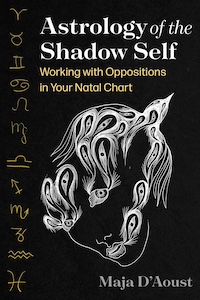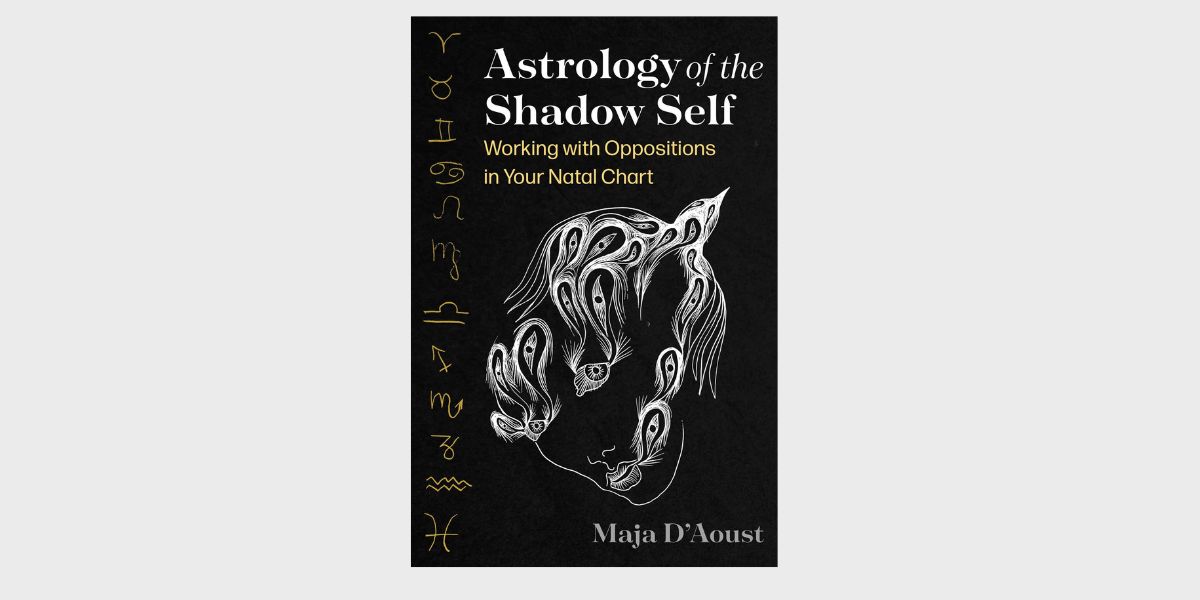
Astrology of the Shadow Self: Working with Oppositions in Your Natal Chart, by Maria D’Aoust
Destiny Books, 164411917X, 352 pages, April 2024
Polarities are what ultimately bring everything into harmony. However, often we wind up focusing on just one side, especially in astrology where everyone wants to read about the specifics of their natal placements, forgetting they are part of a bigger picture and creating an imbalance through neglect of the other half. In Astrology of the Shadow Self: Working with Oppositions in Your Natal Chart, Maria D’Aoust teaches readers how to discover the shadows of their natal places and through this polarity discover wisdom that yields more insight about their strengths and weaknesses.
D’Aoust is a scholar of alchemy, practicing witch, and professional astrologer with over 20 years of experience. She holds a master’s degree in transformation psychology, using her educational background to inform her astrology readings. Her previously published works include The Occult I Ching, Familiars in Witchcraft, A Witch’s Bestiary, and The White Witch Tarot.
In this book, D’Aoust teaches readers about the power of embracing their shadow. In her introduction, she describes how through embracing the “not I” aspects of ourselves, the parts we disown and do not identify consciously with, we can perpetuate oppression, superiority, and victim mindsets–all of which strip ourselves and others of power the more we refuse to acknowledge it.1 It is through embracing these shadow aspects that the full potential of astrology as a tool for healing, self-acceptance, and personal growth can be utilized.
“Here we shall try a new way of dealing with the shadow, the unwanted self, the naughty one. We shall raise it up into power so that it grows and matures. The shadow within us may then ascend and become not a more powerful shadow but rather a more powerful part of our whole self. This prevents the shadow from taking over the self and hiding, lurking in our blind spots, and gives it a chance to actually heal.”2
D’Aoust instructs readers how to create an “antichart”3 where all their natal placements are in the opposite sign and house. This is one’s shadow chart. She also explains how the concept of shadow can be used for transits as well. For instance, when the Sun is transiting Aries, the shadow exploration would be the Sun in Libra. Whether one is curious about their own personal shadow chart or looking to examine the current cosmic influences, D’Aoust’s descriptions of the shadows are a wonderful starting point to further understanding the energy in play.
For each planet–Sun, Moon, Mercury, Venus, Mars, Jupiter, Saturn, Uranus, Neptune, and Pluto–D’Aoust profiles the shadow placements of every zodiac sign. Readers are looking up their shadow placement, rather than their natal placement as they explore the book. For instance, in the Mercury chapter, as an Aquarius Mercury natally, the entry pertaining to me would be Leo Mercury Shadow.
Her entries are very thoughtful and provide great insight into the shadow placement. Each entry has the title, a few word description of the shadow, the corresponding birth planet, parasite of the shadow, a two to three page description of the shadow, and an example from nature (almost always a quote) that grounds the shadow in the natural world.
The first thing I did was read all the entries for the planetary placements in my chart, and right after I also created my husband’s shadow chart and read his entries too. Honestly, reading about our shadow placements opened up a whole new level of dialogue for us and it put a lot of things in perspective. Things that we couldn’t articulate, yet were impacting our relationship (habits, communication styles, emotional relating, etc.) were laid out bare for us to reflect on.
It’s extremely evident that D’Aoust has spent so much time exploring these shadow placements and bridges the gap between psychology and astrology in her writing. Plus, the examples from nature are also something both my husband and I found added a beneficial new layer of understanding to the shadow description. When you can see how the energies manifest in the natural world, it puts things into a context that is tangible.
Another really neat way that I’ve engaged with the book’s text is when writing my new moon manifestations. Every month, I’ll write out a manifestation list in my journal, using present tense as always recommended! Usually, I will draw from the traits of the sign the sun/moon are joining in, for instance Aries was the most recent new moon. But this time I decided to instead explore the shadow of the new moon and read about the Libra Sun Shadow and Libra Moon Shadow. Wouldn’t you know it? I was engaging more with the shadow attribute of the new moon (toxic codependency, not clearly verbalizing my true feelings) more than the Aries attributes!
This made me pause and reflect on how I wanted to attune myself to the new moon energy and write my manifestation list. Rather than just putting all Aries qualities, I choose to focus on transforming the shadow qualities coming through the opposing Libra energy. And my manifestation list felt extra powerful! I’m going to continue exploring the shadow for on-going transits to better understand the full-spectrum of the zodiac shadows beyond just what is apparent in my shadow chart.
“Why must we deal with counterforce? We live in a universe that contains opposition as a physical law of reality; nature is always seeking to reach homeostasis and equilibrium. We find peace not by destroying opposition, for this imbalances the scale, causing the weights to swing wildly; we must only equalize and neutralize.”4
My favorite chapter is “Ophiuchus Shadows: The Venom Master” where D’Aoust examines the shadow of this hidden 13th sign, which many astrologers typically do not acknowledge. I have always been fascinated by Ophiuchus though and was thrilled to see it included. As the sign is between Sagitarrius and Scorpio, D’Aoust explains how the shadows fall in the sign of Gemini. So those with prominent Gemini placements, specifically near the Orion constellation, will have the Ophiuchus shadow. Her interpretation for the shadows is briefer than the other planetary shadows, but it gives a good start point to explore. She notes “Placements here are the venom masters and poison artists, usually studying plants, healing, and medicine.”5
The remaining chapters focus on the shadow of the moon’s nodes, thought to correspond to one’s destiny or life purpose, and D’Aoust’s insight on shadow integration. There’s also the bonus of an epilogue all about eclipses and their relation to shadow. This was another favorite chapter of mine since I was immersed in the book leading up to and during the solar eclipse on April 8th. Perfect timing!
Another thing I really enjoy about this book is how D’Aoust draws from different religious traditions when discussing the shadow and the journey one must undergo to integrate it. There’s examples from Taoism, Christianity, Judaism, alchemy, and more. These examples go to show the archetypal nature of shadow work, as well as offering different perspectives about the experience. There’s also a good deal of depth psychology woven in as well.
All in all, Astrology of the Shadow Self is a must-read book for those with an interest in astrology. It was absolutely the best astrology book I’ve read in a while; none of the material was recycled, depicting the same old as countless books out there. This fresh take and unique perspective of the shadow chart was entirely new to me and already the concepts in this book have enhanced my astrology practice and lead to wealth of personal insight. D’Aoust has done a great service to the astrological community in writing such an insightful book. There is so much we can learn from the shadow, and it’s something we must face if we truly want to transform. This book is a wonderful starting point for those ready to explore their own shadow and immensely expand their astrological knowledge.
Alanna Kali is an astrologer, numerologist, and pioneer spirit that loves to explore life through the lens of depth psychology. She has a passion for studying the humanities and social trends. Her academic work is centered upon reuniting body, mind, and spirit through eco-psychology. She loves reading, spending time in nature, and travel.
